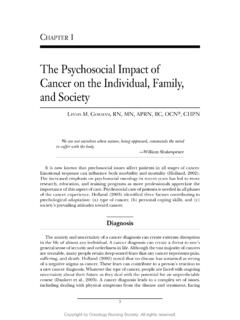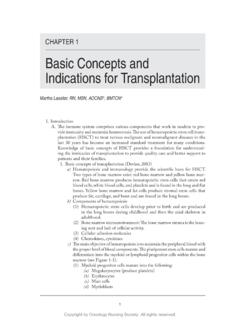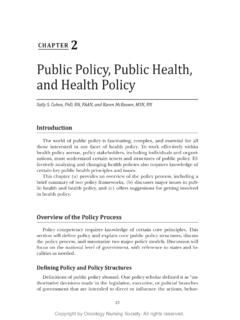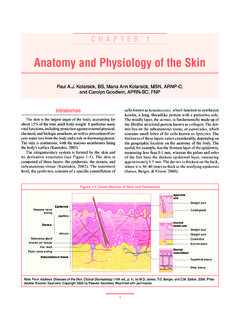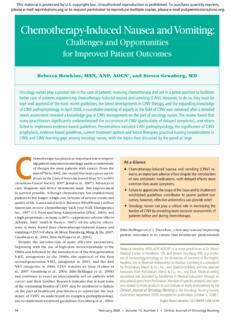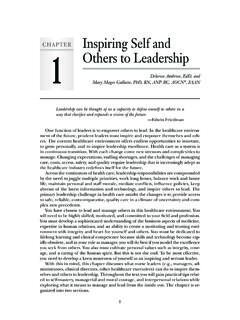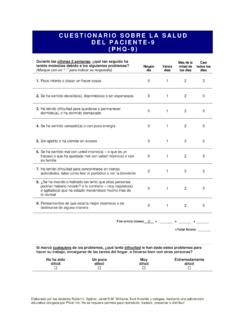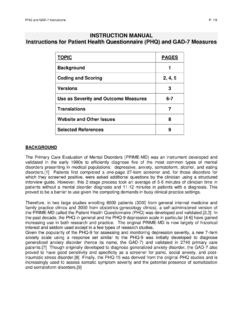Transcription of Cancer Prevention, Screening, and Early Detection
1 1 CHAPTER 1 Cancer prevention , screening , and Early DetectionHeather Greene, MSN, RN, FNP, AOCNP IntroductionIn 2015, an estimated 1,658,370 new cases of Cancer are expected to be diagnosed in the United States, and 589,430 Cancer deaths are expected (American Cancer Society [ACS], 2015). One-quarter to one-third of these Cancer deaths will be related to tobacco use, poor nutrition, physical inactivity, and obesity (World Cancer Research Fund & American Insti-tute for Cancer Research, 2009). All Cancer deaths related to tobacco and alcohol abuse are entirely preventable. Additionally, any of the more than two million new cases of skin can-cer diagnosed annually could be prevented by avoiding overexposure to ultraviolet light.
2 Can-cers related to viral or bacterial infections, such as the hepatitis B virus, human papillomavirus (HPV), HIV, and Helicobacter, also can be prevented through lifestyle changes and use of vac-cines or antibiotics (ACS, 2015).In addition to avoidance of risk factors, routine use of screening modalities can aid in pre-vention and Early Detection of Cancer . screening tests for cancers of the colon, rectum, and cervix can help prevent Cancer by enabling removal of precancerous growths. In addition to reducing incidence, greater use of screening tests could decrease deaths related to breast, colorectal, and cervical cancers (ACS, 2015). Despite this, even mammography use has not increased since 2010. Half of all new cases of Cancer are considered preventable or could be detected at an earlier stage (ACS, 2015).
3 Role of the Advanced Practice NurseOncology advanced practice nurses (APNs) are in a unique position to educate their patients and the public regarding recommended Cancer risk reduction and screening guide-Copyright by Oncology Nursing Society. All rights Advanced Oncology Nursing Certification Review and Resource Manual (Second Edition)lines. The scope of practice for nurse practitioners includes an emphasis on health promotion and disease prevention (American Association of Nurse Practitioners, 2013). Therefore, can-cer prevention and Early Detection are clearly responsibilities of the oncology the Oncology Nursing Society s Scope and Standards of Oncology Nursing Practice: Gen-eralist and Advanced Practice (Brant & Wickham, 2013), oncology APNs are encouraged to receive educational preparation in the principles of Cancer prevention and Early Detection .
4 Oncology specialty certification examinations (such as the advanced oncology certified nurse practitioner [AOCNP ] and advanced oncology certified clinical nurse specialist [AOCNS ] examinations) cover this topic. In accordance with their state s scope of practice, nurse prac-tice act, and requirements for educational preparation, oncology APNs must be able to assess, evaluate, and interpret Cancer risk assessments and recommend appropriate strategies related to Cancer prevention and screening . All oncology nurses must be able to provide culturally sensitive Cancer prevention and Early Detection services and participate in the development of resources that focus on wellness and primary prevention throughout the life span. Research on Cancer prevention and Early Detection requires integration into current Risk AssessmentCancer risk assessment is a vital part of the oncology APN s role in Cancer prevention and Early Detection .
5 To provide accurate counseling on Cancer risk reduction strategies ( , tobacco cessation, lifestyle modifications, dietary changes, chemoprevention agents), Cancer screening recommendations, and genetic testing (if appropriate), oncology APNs must first perform a comprehensive risk assessment. A Cancer risk assessment is an individualized eval-uation of a patient s risk for Cancer based on a variety of both intrinsic and extrinsic factors and begins with a detailed history. This includes thorough past medical, social, obstetric/gyne-cologic, and surgical histories and documentation of recent age-appropriate screening tests, or lack thereof. Family history is a critical part of Cancer risk assessment and includes at least a three-generation pedigree, particularly if a hereditary Cancer syndrome is suspected (see Chapter 2).
6 Medication history (such as hormone use), dietary history, level of physical activ-ity, environmental exposures, history of tobacco and alcohol use, and other lifestyle choices also are important factors to assess when determining Cancer risk. A thorough physical exami-nation concludes the Cancer risk assessment and includes a breast, pelvic or testicular, and rec-tal Cancer risk assessment tools and models are available to help APNs convey this risk to patients, such as the Gail model, Tyrer-Cuzick model, and BRCAPRO for breast Cancer risk (Quante, Whittemore, Shriver, Strauch, & Terry, 2012; Warner, 2011) and the MMRpro model for hereditary colon Cancer risk (Greco, 2007). Each of these tools has its strengths and weaknesses. The Gail model is the most commonly used general breast Cancer risk assessment tool and is used to estimate a woman s five-year risk and overall lifetime risk for breast Cancer .
7 Scores are calculated based on a variety of risk factors, including age, age at menarche, age at first live birth, race, number of first-degree relatives with breast Cancer , and number of previ-ous breast biopsies. The score is based on a comparison to that of a woman of average risk and of the same race and age, with elevated risk considered greater than However, this model fails to take into account the age at breast Cancer diagnosis in affected family members, his-tory of bilateral breast Cancer , second-degree relatives affected with breast Cancer , and history of ovarian Cancer or lobular carcinoma in situ (Quante et al., 2012; Warner, 2011).The National Cancer Institute (NCI) has several Cancer risk assessment tools available online, most prominently those for breast ( ) and colon Cancer Copyright by Oncology Nursing Society.
8 All rights 1. Cancer prevention , screening , and Early Detection 3( ) risk assessment. All of these models are best used in conjunction with an individualized, comprehensive Cancer risk assessment by the APN to best estimate and counsel patients on their overall Cancer risk and on interventions to decrease that prevention and Risk ReductionCancer prevention is achieved through primary, secondary, and tertiary methods. Pri-mary Cancer prevention consists of interventions aimed at keeping the carcinogenic process from beginning. Examples include smoking cessation interventions and chemoprophylaxis in women at high risk for breast Cancer . Secondary Cancer prevention is the discovery of can-cerous or precancerous conditions while still in their earliest stage, when the disease is most likely to be treated successfully (Spratt, 1981).
9 Examples include mammography to detect and remove premalignant changes in the breast and colonoscopy to remove polyps in the colon. Tertiary Cancer prevention is applied to those individuals who have already been diagnosed with a malignancy with the intent of keeping the original disease in remission as long as UseSmoking has long been established as a detriment to overall health. As Early as 1928, stud-ies have referred to smoking and its association with Cancer (Lombard & Doering, 1928). Research culminated with the 1964 Department of Health, Education, and Welfare s Sur-geon General s report, which concluded that smoking was the major cause of lung Cancer and was associated with oral and laryngeal cancers in men. Since then, thousands of additional studies and subsequent reports of the Surgeon General have confirmed tobacco s detrimental health effects.
10 More than 4,000 chemicals have been identified in tobacco products and tobacco smoke, 55 of which are identified as carcinogens by the International Agency for Research on Cancer . These carcinogens may induce genetic mutations and ultimately lead to Cancer devel-opment. In 2015, nearly 171,000 deaths will be attributable to tobacco (ACS, 2015). Tobacco use is considered a contributing or causative agent in a multitude of malignancies, including lung, nasal cavity, larynx, pharynx, esophagus, stomach, colon, rectum, liver, pancreas, kid-ney, bladder, uterine cervix, ovary (mucinous), and myeloid leukemia (ACS, 2015; Centers for Disease Control and prevention [CDC], 2004). Smoking is thought to cause up to 90% of lung cancers and is the leading cause of preventable Cancer -related and non Cancer -related deaths in the United States (ACS, 2015).

